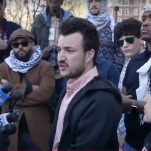As White Supremacists Fill the Headlines, Will It Be White Journalists Who Cover Them?
LatestThe video, in which Reeve is embedded with Cantwell and other white supremacists as they travel through the protests, has been viewed over 40 million times and exposes the depth of these vile beliefs in a way that is difficult to dismiss. In it, Reeve walks alongside white nationalists with steely resolve as they chant Nazi slogans like “Jews will not replace us,” and “blood and soil.” Cantwell tells her he’s “trying to make myself more capable of violence” against blacks and Jews, and unloads multiple firearms and a knife in his hotel room. The documentary is chilling and vital. But watching it, I realized that though I am among those most endangered by Cantwell’s rhetoric, as a brown journalist I would never be able to talk to white supremacists without a certain base-level fear of potential harm in the way that Reeve, who is white and blonde, was able to.
To be clear, plenty of non-white journalists have interviewed white supremacists. But in the recent mainstream resurgence of white nationalists, most have done so in controlled, sterile environments—intentionally neutral ground which tends to obscure the violence they advocate. On Viceland, Asian-American chef Eddie Huang ate a fancy dinner with white nationalist Jared Taylor while Taylor calmly explained why America belonged to the white race. In the CNN documentary series United Shades of America, host W. Kamau Bell sat down with white nationalist Richard Spencer to talk about Spencer’s desire to “bathe in white privilege.” The tone of the interview, which received enough criticism that Bell responded to the backlash with an op-ed, was conversational and even friendly. But Taylor and Spencer, who appear clean-cut and wear crisp collared shirts, put on an air of respectability that deliberately paints their racism as more palatable than that of Cantwell. Though these neutral environments maintain a safer way for reporters of color to gain access to hostile interview subjects, this type of profile can reinforce the same “sophisticated fascist” trope already proliferated by the media.
When reporters of color do embed themselves with white supremacists on their own turf, they can be putting themselves in real, palpable danger. Last month, Univision’s Ilia Calderón visited North Carolina KKK leader Christopher Barker with a small production crew in Yanceyville and confronted him not in a sanitized conference hall, but on his own yard. During the interview, released last week, Barker called her “nigger” and threatened to “burn” Calderón “out” of his property and, symbolically, out of America, because she’s a black immigrant:
“Are you going to chase me out of here?” Calderón asks.
“No, we’re going to burn you out,” Barker says.
“Oh, you’re going to burn me out?” Calderón says, without losing composure.“How are you going to do it? How are you going to do it with 11 million immigrants?”
“Don’t matter,” he responds. “Hey, we killed 6 million Jews the last time. 11 million is nothing.”
“You’re telling me that you’re going to burn me,” she says.
“Yeah. You’re sitting in my property now.”
“He was so furious that a black person stepped in. Some of those names that he called me, I didn’t even hear them before in my life,” Calderón told Jezebel over the phone. “He was not physically violent, but all his body language and speech was hate.”
Throughout their conversation, Calderón pushed back against Barker’s rhetoric aggressively, even asking Barker point-blank, “Are you racist?” (He responded, “No”). Though she leaned forward, challenging him with a raised voice, she was visibly rattled by his outright threat of violence.
“It was hard. It was hard, but at the same time, it is what people out there are facing everyday, you know?” she told Jezebel of her reaction to Barker’s threats. “It was a combination between being scared and at the same time, strong. Like I’m not going to move from here. He’s not going to make me leave.”
Some viewers asked Calderón why she accepted the interview with Barker at all, knowing already that she’d be stonewalled. Her response:“My skin color cannot limit my work as a journalist.”
“I wanted to show the world who are they, where are they, how do they think, why do they hate us, what are the reasons why. I just wanted to face hate,” she said. “I just wanted to look into his eyes and ask him, Why do you hate me because of what I represent?”
-

-

-

-

-

-

-

-

-

-

-

-

-

-

-

-

-

-

-

-

-

-

-

-

-

-

-

-

-

-

-

-

-

-

-

-

-

-

-

-








































